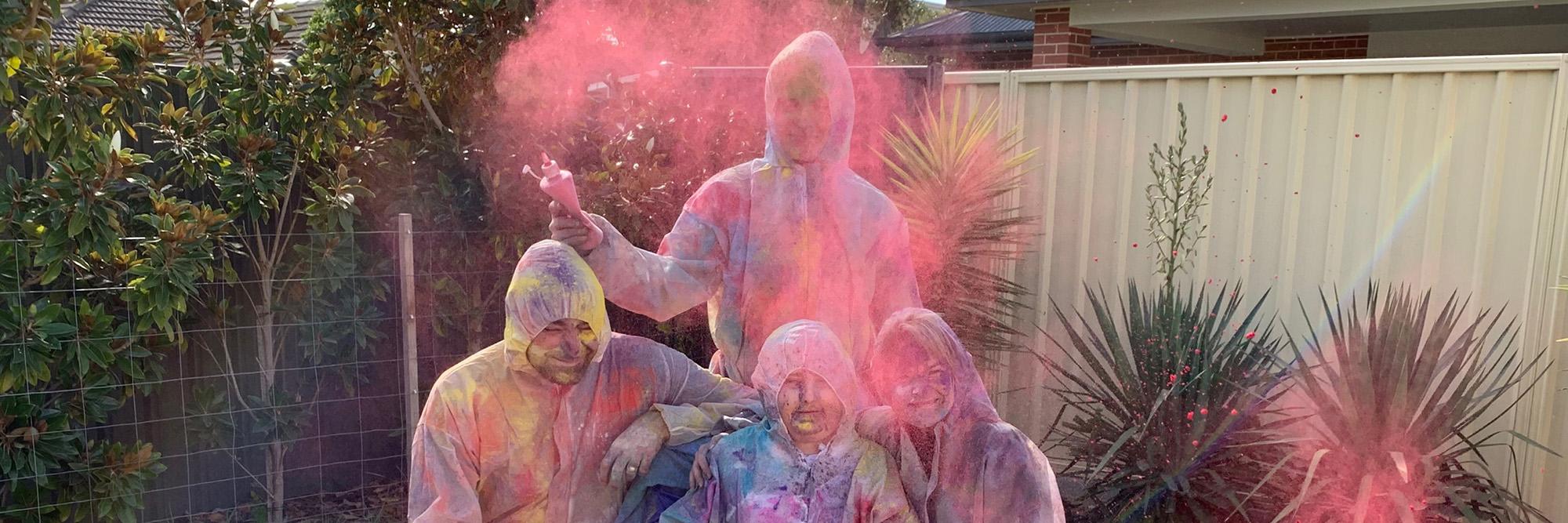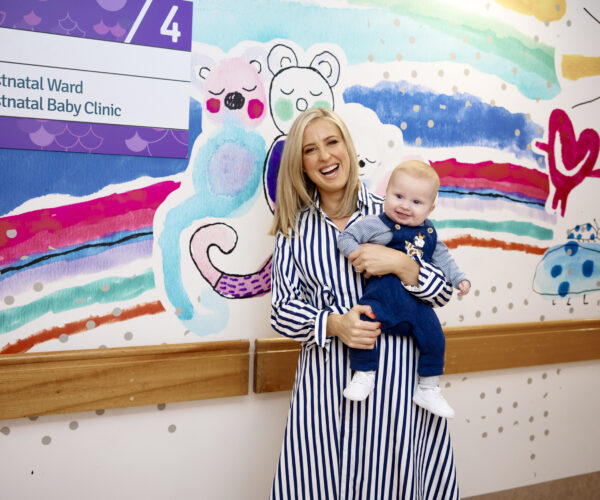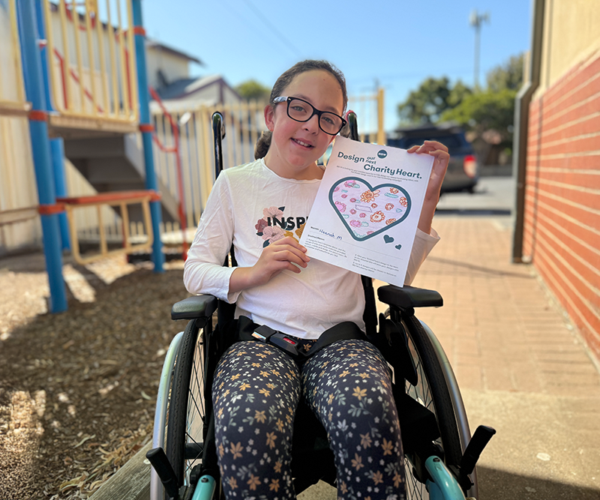Patients receiving end-of-life care at the Women’s and Children’s Hospital (WCH), as well as their families, have the opportunity to explore and express their emotions and communicate thoughts and feelings when they are unable to find the words through illness and into bereavement. Art Therapy is offered as an integral part of the Paediatric Palliative Care Service (PPCS).
What is Art Therapy?
Art Therapy is not just art making, but a therapeutic intervention. Aligned with the WCH Foundation Arts in Health program, Art Therapy uses a creative approach to healthcare and wellbeing.
Art Therapist, Lauren, says, “Our role is to support patients, siblings and families. We deliver services in the Hospital community, schools and in home visits. Every day can look different.”
Art Therapists help families to be able to talk about end-of-life and help them to understand what grieving might be like.
An Art Therapy session could consist of painting, collage, sculpting, clay, construction, movement, sound – anything that resonates with the person and their experience through creative expression, whilst processing with the support of the Art Therapist.
“Often there’s no end product, it’s a process,” Lauren says.
The process really empowers the child to have some choice and control in their situation, to be seen, heard and witnessed, not just as their illness, but who they are.
Art Therapists try to have the voice of the child in the process and bring that to the centre of care always.
Lauren says, “For children to be able to express their voice through art making processes, and in relationship with their therapist, really helps support and guide their care. While it may feel scary and ‘really big’ for the child, providing opportunities to express difficult emotions can support a felt sense of safety, choice and control which often leads to reassurance for the family.”
It can be hard for children to make sense of big feelings though, so Art Therapy helps to make meaning in a way that is easier to understand. Rather than relying on dialogue or verbal communication, Art Therapists try to find other sensory ways for them to express themselves.
Using art as a different way of expressing is more sensory and body-based and can change the approach. The process can be really freeing for many because it doesn’t have the limitations that people often have when trying to express something verbally
An Art Therapist’s role isn’t to fix things, but to sit with these feelings.
Lauren says, “A really incredible part of Art Therapy is that art supports holding the enormity of feeling scared around dying – feeling so overwhelmingly sad – and being with children and their feelings rather than us fixing.”
“I think children are so courageous and incredible to continue to show up and be able to express and process and really lead their family through the mess.”
“For many years, I’ve seen young people lead their family through diagnosis, through the illness, through death, and then how that continues to lead the family in bereavement is really special.”
Mitchell’s story
When Mitchell was 12 years old, he was travelling through the US with his family when things took a turn for the worst quickly and unexpectedly. Mitchell suffered a seizure and was admitted to hospital while his parents, Kylie and Scott, and brother, Lachlan, were left wondering what was happening.
Mitchell was medevacked back to Adelaide where he was diagnosed with a form of glioma, a highly aggressive brain tumour. He was placed under the care of the PPCS where his family were introduced to Art Therapy at the WCH.
Kylie was open to the idea, but Scott admits he was not as keen and Mitchell went immediately to, “No.”
The pair encouraged Mitchell to have a go though.
“So he did,” Scott says, “And he never really looked back.”
Lauren built up a wonderful relationship with Mitchell as his Art Therapist and would visit on a weekly basis. The sessions were led by him and how he was feeling on the day.
One of the memorable sessions for Kylie involved making a mess with a whole lot of shaving cream.
Kylie says, “Mitch got to the point that he really couldn’t move much other than his hands. So they did this massive shaving cream mess.”
“He’d said that he wanted me to come in, so I’ve come in there, and I’m looking at this mess, and Lauren is saying, ‘He wants you to be involved,’ so I’ve got my hands in it.
“It was really interesting though, because every time the shaving cream went over the edge, I was madly trying to put it back and make it all right and control it.”
“So, that was a bit of a ‘Well actually, I don’t have any control over this,’ realisation.”
A turning point for the family was understanding that Mitchell wanted the rest of his family to be immersed in the mess of his situation alongside him, which came out of an amazing Art Therapy session of throwing coloured paint around at each other in their backyard.
“For me, that was when it started to all make sense,” Scott says.
Kylie says, “In that situation, we were actually able to laugh.”
“That was a big message that we got out of that as well, that as hard as it is, we’re all in it together, we’re still going to find those lighter moments where we can enjoy the memories.”
The family say that not having to sit down and directly talk about what they were going through, but instead creating other ways for them to communicate with each other, helped make things easier.
“It was a conduit for discussions that were just really hard to have,” Scott says.
“Art Therapy was breaking down the really confronting things to talk about, and it gave Mitch a voice that he otherwise wouldn’t have had.”
“It gave us all a bit of a way to find a way through it and talk about it and communicate it without having to use words.”
“Art Therapy kept bringing us back as a family,” Kylie says.
Mitchell fought a tough battle with his cancer before passing away at age 13. In the time leading up to this, he worked incredibly hard with Lauren to create a poem and legacy bracelets for the people closest to him. These reminders of him mean everything to his loved ones now.
Kylie says, “I feel like he left feeling like he gave us his legacy, and we were able to show him through Art Therapy the love and the fact that we knew how hard it was that he was going through that.”
“He wanted to make sure that we were going to be okay. He went from this scared boy, thinking, ‘Why is it all happening to me?’ to then getting to acceptance and saying, ‘Well, now I need to know that everyone is going to be okay.’ That was his legacy.”
“It was a holistic approach to give him the opportunity to move through his emotions and to process them, and knowing he did that, even though it was hard, is what makes it okay for us now.”
Art Therapy expansion
The PPCS provides responsive, flexible and client-centred Art Therapy services to children and families experiencing a life-limiting illness.
In order to better meet the needs of the increased referral base, and to ensure the PPCS can provide equitable and responsive services, the Art Therapy service has been able to grow to meet this need with the help of generous support from the Roberts family and their ongoing fundraising efforts through Cycle 4 Sam and Challenge 21.




